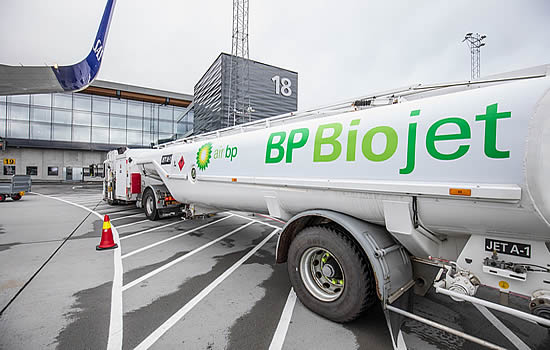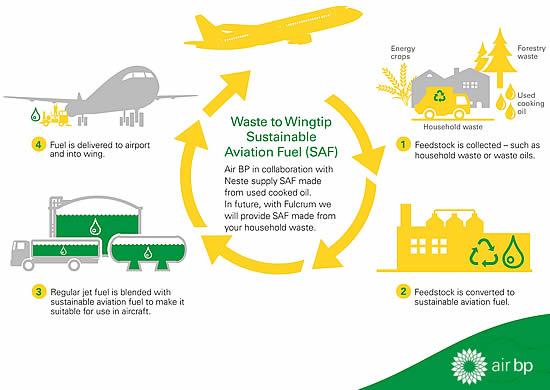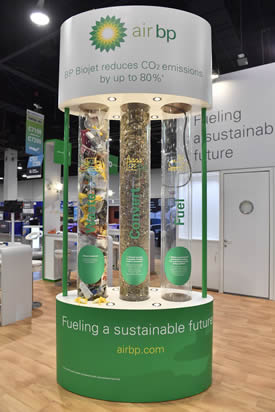What is Sustainable Aviation Fuel (SAF)?
Tom Parsons Air BP’s Commercial Development Manager, Low Carbon, gives the low down on Sustainable Aviation Fuel.
The use of sustainable aviation fuel (SAF) is on the rise, but what is it exactly?
SAF stands for sustainable aviation fuel. It’s produced from sustainable, renewable feedstocks and is very similar in its chemistry to fossil jet fuel. Using SAF results in a reduction of CO2 emissions compared to fossil jet fuel over the lifecycle of the fuel.
Some typical feedstocks used are cooking oil and other non-palm waste oils from animals or plants; solid waste from homes and businesses, such as packaging, paper, textiles, and food scraps that would otherwise go to landfill or incineration. Other potential sources include forestry waste, such as waste wood, and energy crops, including fast growing plants and algae. Air BP’s SAF is called BP Biojet and is currently made from used cooking oil and other waste.

Why is SAF important?
Jet fuel packs a lot of energy for its weight and it is this energy density that has really enabled commercial flight. Today, there aren’t any other viable options for transporting groups of people quickly over very long distances, so we’re dependent on this type of fuel in aviation. A return flight between London and San Francisco has a carbon footprint per economy ticket of nearly 1 ton of CO2. That’s the same as driving a diesel car 3,750 miles or 6,035 kilometers. With the aviation industry expected to double to 8.2 billion passengers by 2037, it is essential that we act to reduce aviation’s carbon emissions and SAF is one way in which Air BP is doing that.
How much carbon (CO2) does it save?
Sustainable aviation fuel (SAF) gives an impressive reduction of up to 80% in CO2 emissions over the lifecycle of the fuel compared to fossil jet fuel, depending on the sustainable feedstock used, production method and the supply chain to the airport.
When did Air BP first test SAF?
In 2010 Air BP teamed up with Brazilian airline TAM (now LATAM) for a test flight using SAF.
Who does Air BP partner with to make SAF available?
Air BP has announced collaborations with two companies: in 2018 the company signed an agreement with leading renewable fuel producer Neste, which produces sustainable available fuel made from non-palm oil based used cooking oil and other wastes and residues. Through this collaboration we are developing new SAF supply chains.
In 2016 Air BP created a strategic partnership with Fulcrum BioEnergy with an initial investment of $30 million. The Californian company is building its first plant in Reno, Nevada, which will produce sustainable transport fuel made from household waste. Fulcrum intends to construct additional facilities and ultimately plans to supply us with over 50 million US gallons of SAF per year.

Is it safe to use?
SAF can be blended at up to 50% with fossil jet fuel and all quality tests are completed as per a regular jet fuel. Once blended, SAF has the same characteristics as fossil jet fuel. The blend is then re-certified as Jet A or Jet A-1. It can be handled in exactly the same way as a regular jet fuel, so no changes are required in the fueling infrastructure or for an aircraft wanting to use SAF. In 2016, we were the first operator to commence commercial supply of SAF through an existing hydrant fueling system, at Norway’s Oslo Airport, using BP Biojet.
Is SAF suitable for all aircraft?
Any aircraft certified for using the current specification of jet fuel is able to use SAF.
Who has Air BP supplied?
To date, Air BP has supplied SAF at 15 locations in five countries across three continents. Air BP’s SAF has been used to fuel many different types of aircraft from small private jets to large passenger aircraft. We have a supply chain established in Sweden, from which we are supplying locations across the region. It was this supply chain that enabled us to fuel Braathens Regional Airlines for its ‘Perfect Flight’ back in May, which combined the latest in aircraft efficiency and the use of SAF to cut emissions by 46% compared to regular flights on the same route. We have also supplied SAF for Delta Air Lines and Airbus in the USA this year. In all, we have supplied around 20 different customers with SAF so far.
How does the cost of SAF compare to fossil jet fuel?
SAF is currently more costly than fossil jet fuel. That’s down to a combination of the current availability of sustainable feedstocks and the continuing development of new production technologies. As the technology matures it will become more efficient and so the expectation is that it will become less costly for customers. We are seeing increased uptake of SAF as our customers and their passengers increasingly recognize and value the benefits of the emission reductions.
Is SAF really the key to making aviation greener?
SAF can drop straight into existing infrastructure and aircraft. It has the potential to provide a lifecycle carbon reduction of up to 80% compared to the fossil jet fuel it replaces.
SAF will play a really important role in meeting the aviation industry’s carbon reduction targets, however, we need to use all the options to reduce carbon that we have available.
There are several broad opportunities for carbon reduction across the industry such as more efficient aircraft design, smarter operations and the development of future technologies like electrification. In that regard,
Air BP was the first aviation fuel supplier to be independently certified carbon neutral for into-plane fueling operations at 250 Air BP locations in October 2016
So why aren’t more airlines using SAF?
At the moment, production of SAF is limited as the higher cost for SAF is preventing wider uptake. Air BP is working on helping create more demand in the short-term which will lead to more production and hopefully lower costs in future.
How can we accelerate the growth of SAF?
According to the Air Transport Action Group (ATAG), worldwide flights produced 895 million tons of CO2 in 2018. There is real commitment from the industry to reduce the impact of aviation on the environment, but governments also need to create the right policies to accelerate the growth of SAF. Increasing production requires long-term policy certainty to reduce investment risks, as well as a focus on the research, development and commercialization of improved production technologies and innovative sustainable feedstocks.
On an individual level, some airlines are now providing passengers and corporate customers with the option to fund SAF blending directly in order to reduce emissions associated with your ticket, and we think these are really positive initiatives.
The key to greater acceptance and deployment of SAF is reduction in costs. Over the long term, that will require investment in advanced technologies to process feedstocks more efficiently at greater scale and investment in the development of sustainable and scalable feedstock options. However, in the short-term, interim support from governments and other stakeholders through policy incentives is needed. This support, needs to be part of a long-term framework to give investors the confidence to make the big investments required to grow supply.
| © BlueSky Business Aviation News Ltd 2008-2019 |



